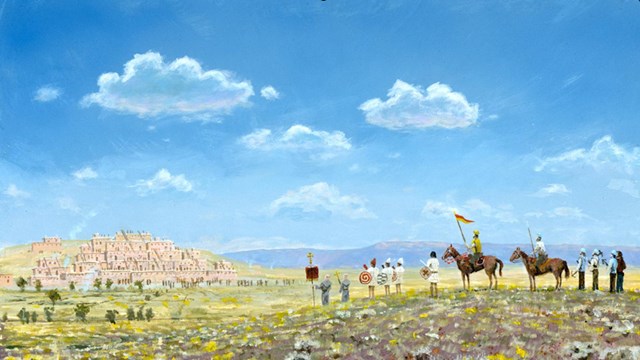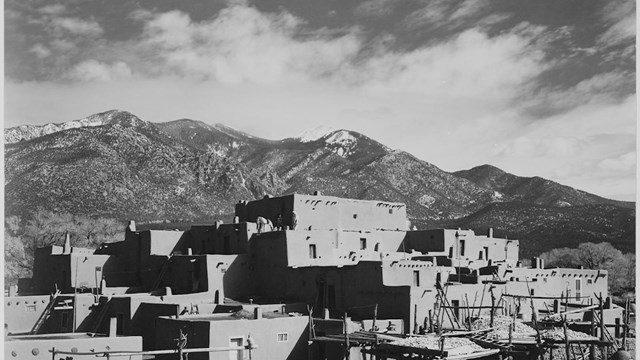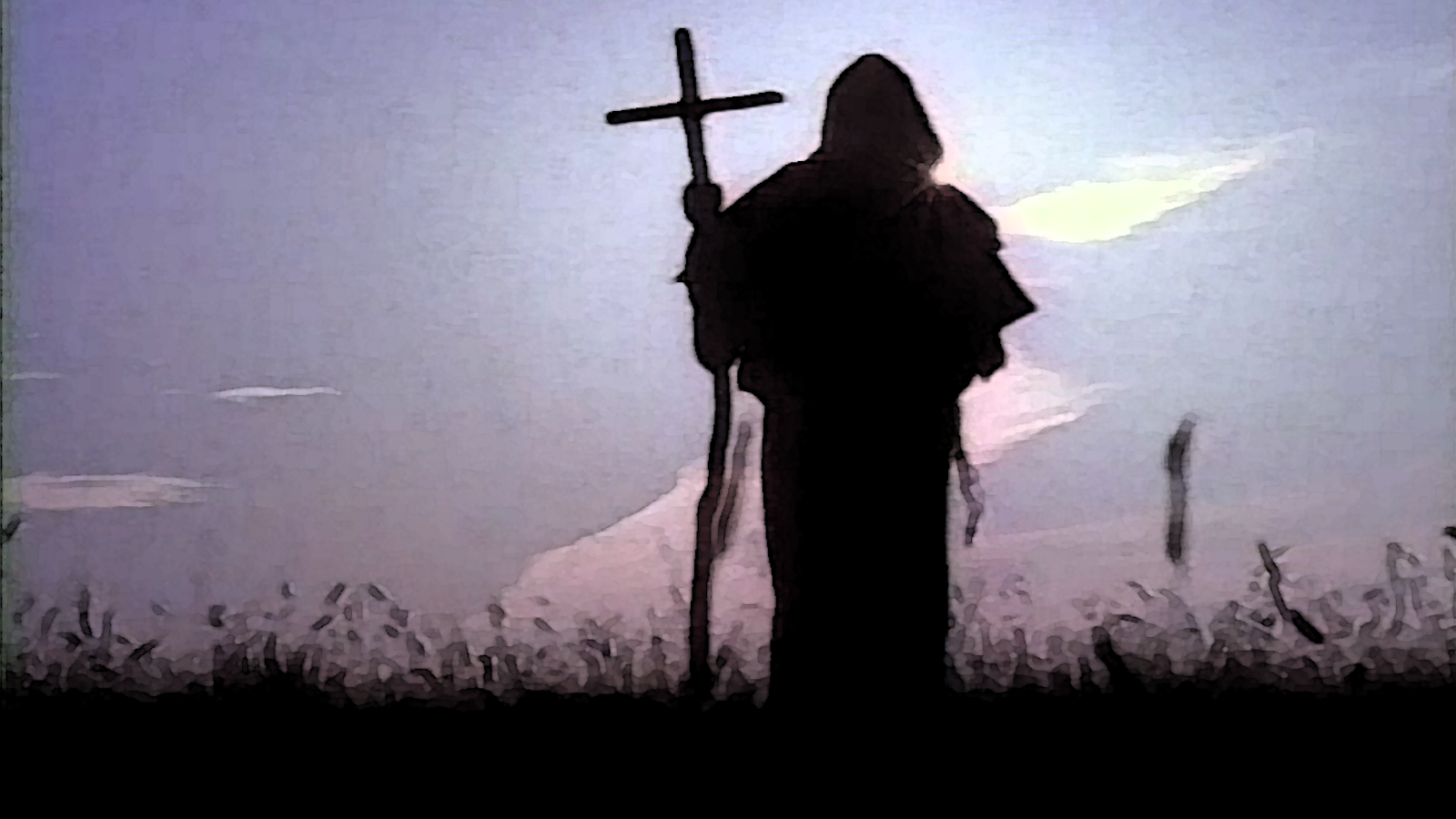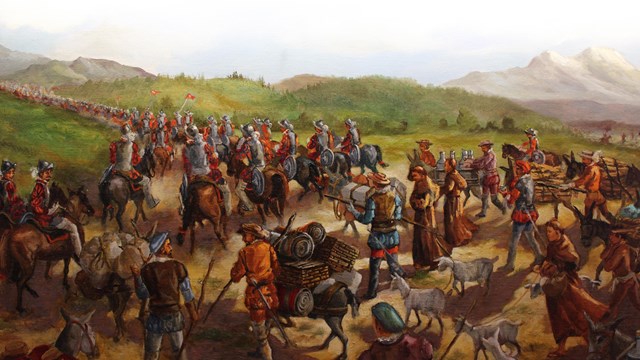The Coronado ExpeditionThe arrival of the entrada into "Tierra Nueva" in 1540, led by commander and captain general Francisco Vázquez de Coronado, set about a dramatic cultural and biological exchange. The armed expedition consisted of over 300 armed Europeans, at least 1200 indigenous allies, a handful of Franciscan priests, and scores of servants and enslaved peoples. Their arrival in northwest Mexico and the American Southwest irrevocably changed the lives and cultures of the indigenous peoples of the region, some of whom had lived here for centuries. This moment marks a period of cultural collapse, and sparked an era of cultural fusion, the result of which is still palpable in the region.For a brief history of the Coronado Expedition, view the video below. Para una breve historia de la Expedición ver el video. Coronado National Memorial was established to interpret the Coronado Expedition. While there is no physical evidence of the expedition in the present memorial, the park offers a sweeping view of the San Pedro River which is widely regarded as the corridor that the expedition used on their way north to the mythical Cíbola. |

The Seven Cities of Cíbola
A history of the Coronado entrada of 1540 - 1542 
The Tiguex War
In 1541, the Tiguex people had reached the limits of tolerance of the Spanish and other expeditionaries' cruelty and entitlement. 
People on the Expedition
It wasn't just Coronado and his captains on the journey. Many people made up the expedition - priests, Aztec allies, herders, and many more 
Combining Cultures
Think of Italian food without tomato, Switzerland without chocolate, or Thai cuisine without peppers. These all came from the new world... 
The Route of the Coronado Entrada
What route did the Coronado Expedition take from Mexico to Kansas? This scholarly passage tracks the entrada through Sonora and Arizona TranscriptThe Spanish arrival in the new world brought about one of the most dramatic cultural and biological exchanges in recorded history. Within half a century a small number of men explored and conquered an area five times the size of the Roman Empire. In 1492, Columbus arrived with 89 men and three small ships. In 1523 Cortes conquered Mexico. The gold from these conquests made the fortunes of many conquistadores, and wet the appetite of many more. The lands to the north of New Spain continued to be Terra Incognita. Expeditions pushed north from different directions into a vast continent of unknown distances and imagined wealth. The Narvaez Expedition to Florida started with 400 men. Eight years, four survivors reached the northern frontier of New Spain on foot. These men saw no gold on their odyssey, but they heard of vague stories of civilizations to the north who built large stone cities. The Viceroy of New Spain was very interested but cautious enough to send a small group led by a Franciscan priest, Fray Marcos de Niza, they were to go and see these cities and report back. Four months later Fray Marcos returned full of great news about the golden cities he had seen in the distance. Whether this was a product of wishful thinking, or some planned deception is difficult to say. Again and again his stories would turn out to be complete falsehoods. With these glowing reports from Fray Marcos the Viceroy organized an expedition. He appointed 30 year old Francisco Vazquez de Coronado to head the expedition. The Viceroy set three goals for the expedition: to find the seven cities of gold described by Fray Marcos, to spread the word of God, and to expand the realm of Spain in the new world. Coronado was intent upon good relations with the Indians and wrote that he would "try to win them over with good deeds and kindness, but if I should fail I shall try to do it by whatever means should be more suitable to the service of God and Your Majesty". After five difficult months on the trail, Coronado and an advanced party reached the golden cities. They were very disappointed. The pueblo cities were impressive buildings on stone. But there was no gold or precious gems. The Zuni Indians at Hawikuh, the first pueblo the Spaniards encountered, were not happy to see the expedition. They made ceremonial corn meal lines on the ground which they warned the Spaniards not to cross. Coronado sought to convince the Indians that they should welcome the opportunity to become subjects of the king and spiritually saved. The Indians were not impressed and fired arrows at the Spaniards soldiers. Coronado's men were close to starvation after the long trip. After a short but fierce fight the Indians abandoned the pueblo. They realized that they could not stand against Spanish technology. Horses, armor, and steel swords were at the time an unbeatable combination. Acting on information from the Zuni Indians, Coronado sent his captains out to explore the Grand Canyon and Hopi Pueblos to the northwest, and the Rio Grande and plains to the east where they met the friendly Indians of the Tiguex Pueblos. The entire expedition wintered in one of these pueblos, taking whatever was needed and straining relations with the inhabitants. While there, the Spaniards met a captive Indian who said that he was from a land called Quivera, far to the northeast, and that his homeland had much gold and silver. It is possible that the pueblo Indians were at the origin of this effort to move the Spaniards away, out on to the endless plains. Taking the Indian from Quivera as their guide, the expedition set out through the mountains to begin the trek across the plains. Coronado and a small advanced party reached Kansas before it became obvious that there was nothing but the ephemeral villages of the Plains Indians. Finally, stopping deep in the grasslands they executed the Indian for having deceived them and turned back. It was on a day of rest during the return trip that Coronado was thrown from his horse and sustained a severe concussion. A gloom overtook the expedition that was to persist. All thoughts of further exploration slowly dissipated, and the expedition headed back down the trail to Mexico City. Coronado died in obscurity ten years later, a broken man, his expedition considered a complete failure. Fifty years would pass before the next Spanish Expedition would return to these lands. It would come without the dreams of golden cities. They would come to stay. The meeting of the two worlds also resulted in changes: the introduction of the horse proved to be a welcome addition to the nomadic lifestyles of some Indian tribes, but influenced others to forego their traditional ways. New foods provided much additional nourishment to the native peoples diet but often meant changing their way of life. The Christian concepts professed and taught by missionaries were eventually accepted by many Native Americans and became deeply entwined in their outlook on life. The language, architecture, social customs, food, religion, and laws of both people are indelibly woven into the fabric of the Southwest. Spaniard, Navajo, Pueblo, a hundred ethnic identities creating a thousand shades moving toward a new sense of who we are. The rich culture of the Southwest, owes its existence in part to the Spaniards and among them, the most notable, Francisco Vazquez de Coronado.
Visit our keyboard shortcuts docs for details
A brief history of the expedition of which Coronado National Memorial commemorates. This is the old park film that used to play in the park visitor center. It was created in the 1980s. It is dated, but the information is (mostly) good. La versión española está abajo:
Visit our keyboard shortcuts docs for details
El video trata sobre la expedición de Francisco Vázquez de Coronado de 1540 |
Last updated: July 25, 2025
